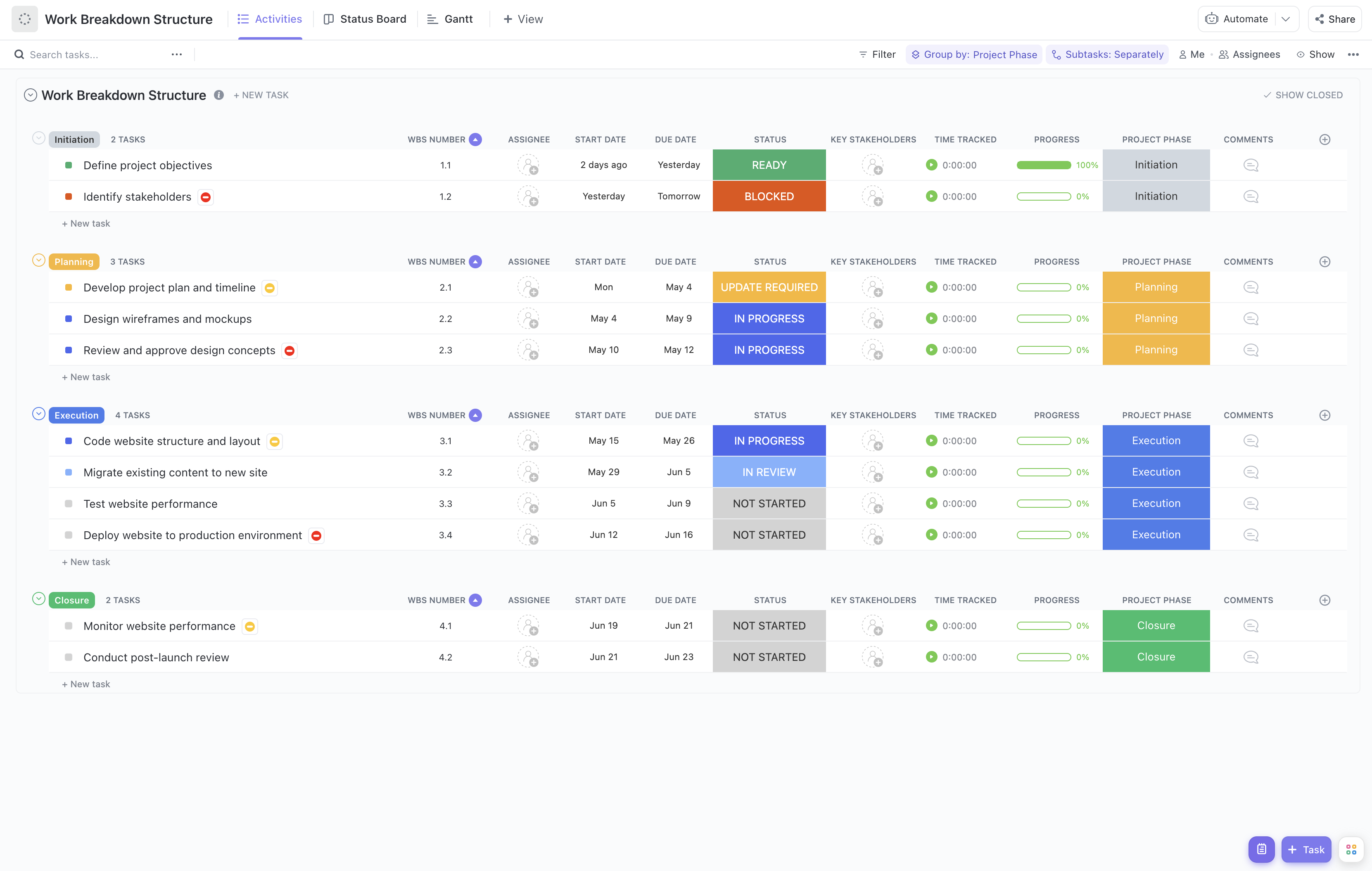When it comes to security, you can't afford to leave anything to chance. That's why having a structured approach to your security projects is crucial. With ClickUp's Security Work Breakdown Structure (WBS) Template, you can ensure that every aspect of your security initiatives is carefully planned and executed.
This template empowers you to:
- Break down complex security projects into manageable tasks and subtasks
- Assign responsibilities to team members and track progress effortlessly
- Collaborate seamlessly with stakeholders to ensure everyone is on the same page
- Maintain a clear and organized overview of all security-related activities
From risk assessments to implementing robust security measures, ClickUp's Security WBS Template is your go-to tool for effectively managing your security projects. Get started today and take control of your security efforts like never before!
Benefits of Security Work Breakdown Structure Template
When it comes to ensuring the security of your organization, having a structured approach is essential. The Security Work Breakdown Structure Template provides numerous benefits, including:
- Streamlining the planning and execution of security projects
- Breaking down complex security tasks into manageable and actionable steps
- Enhancing collaboration and communication among security teams
- Improving resource allocation and time management for security initiatives
- Ensuring compliance with industry standards and regulations
- Increasing overall security effectiveness and reducing vulnerabilities
- Providing a clear roadmap for implementing and maintaining security measures.
Main Elements of Security Work Breakdown Structure Template
ClickUp's Security Work Breakdown Structure template is designed to help you efficiently manage your security projects with ease. Here are the main elements of this List template:
- Custom Statuses: Track the progress of your security tasks with 6 different statuses, including Open, Cancelled, Complete, Delayed, In Progress, and Needs Input, ensuring clear visibility and accountability throughout the project lifecycle.
- Custom Fields: Utilize 9 custom fields such as Project Phase, Allocated Budget, Consulted, Progress, Remaining Effort Hours, Responsible, Accountable, Cost Type, and Informed to capture and organize crucial information related to your security projects, enabling you to make informed decisions and effectively manage resources.
- Custom Views: Access 5 different views including Activities, Status, Gantt, Getting Started Guide, and Timeline, allowing you to visualize your security project from various perspectives, track progress, and plan timelines efficiently.
- Project Management: Leverage ClickUp's powerful project management features like Gantt charts, task dependencies, and workload view to streamline your security project management process, ensuring smooth execution and timely completion.
How to Use Work Breakdown Structure for Security
When it comes to creating a Security Work Breakdown Structure (WBS), it's important to follow these steps to ensure a comprehensive and effective plan:
1. Define project scope and objectives
Start by clearly defining the scope and objectives of your security project. What specific security measures or initiatives are you looking to implement? Are you focused on physical security, cybersecurity, or both? Understanding the scope and objectives will help you determine the necessary tasks and deliverables for your WBS.
Use Goals in ClickUp to define and document the scope and objectives of your security project.
2. Identify major security categories
Next, identify the major categories or areas of security that need to be addressed within your project. This could include access control, surveillance, network security, incident response, and more. Breaking down your project into these categories will provide a structured framework for organizing your tasks.
Use the Board view in ClickUp to create columns for each major security category and easily move tasks between them.
3. Break down tasks and subtasks
Now it's time to break down each major security category into specific tasks and subtasks. For example, under the access control category, you may have tasks such as installing security cameras, implementing key card systems, and conducting security audits. Be sure to include all necessary actions and milestones for each task.
Use tasks and subtasks in ClickUp to break down each major security category into actionable items and assign them to team members.
4. Assign resources and timelines
Once you have identified all the necessary tasks and subtasks, it's important to assign resources and timelines to each one. Determine who will be responsible for completing each task and estimate the time required for completion. This will help you allocate resources effectively and ensure that your security project stays on track.
Use the Gantt chart in ClickUp to visualize the timeline of your security project and assign resources to each task.
By following these steps and utilizing ClickUp's features, you can create a comprehensive Security Work Breakdown Structure that will guide your team towards successful implementation of your security initiatives.

Get Started with ClickUp's Security Work Breakdown Structure Template
Security teams can use this Security Work Breakdown Structure Template to effectively plan and manage security projects and tasks.
First, hit “Get Free Solution” to sign up for ClickUp and add the template to your Workspace. Make sure you designate which Space or location in your Workspace you’d like this template applied.
Next, invite relevant members or guests to your Workspace to start collaborating.
Now you can take advantage of the full potential of this template to ensure the security of your organization:
- Use the Activities View to break down security projects into smaller tasks and manage their progress
- The Status View allows you to quickly see the status of each task and take necessary actions
- Utilize the Gantt View to visualize project timelines, dependencies, and resource allocation
- The Getting Started Guide View provides helpful instructions and guidance to help you get started with the template
- Use the Timeline View to view and manage tasks based on their start and end dates
- Organize tasks into six different statuses: Open, Cancelled, Complete, Delayed, In Progress, Needs Input, to keep track of their lifecycle
- Update statuses as you progress through tasks to keep team members informed of their progress
- Monitor and analyze tasks to ensure maximum security and efficiency in your projects.









